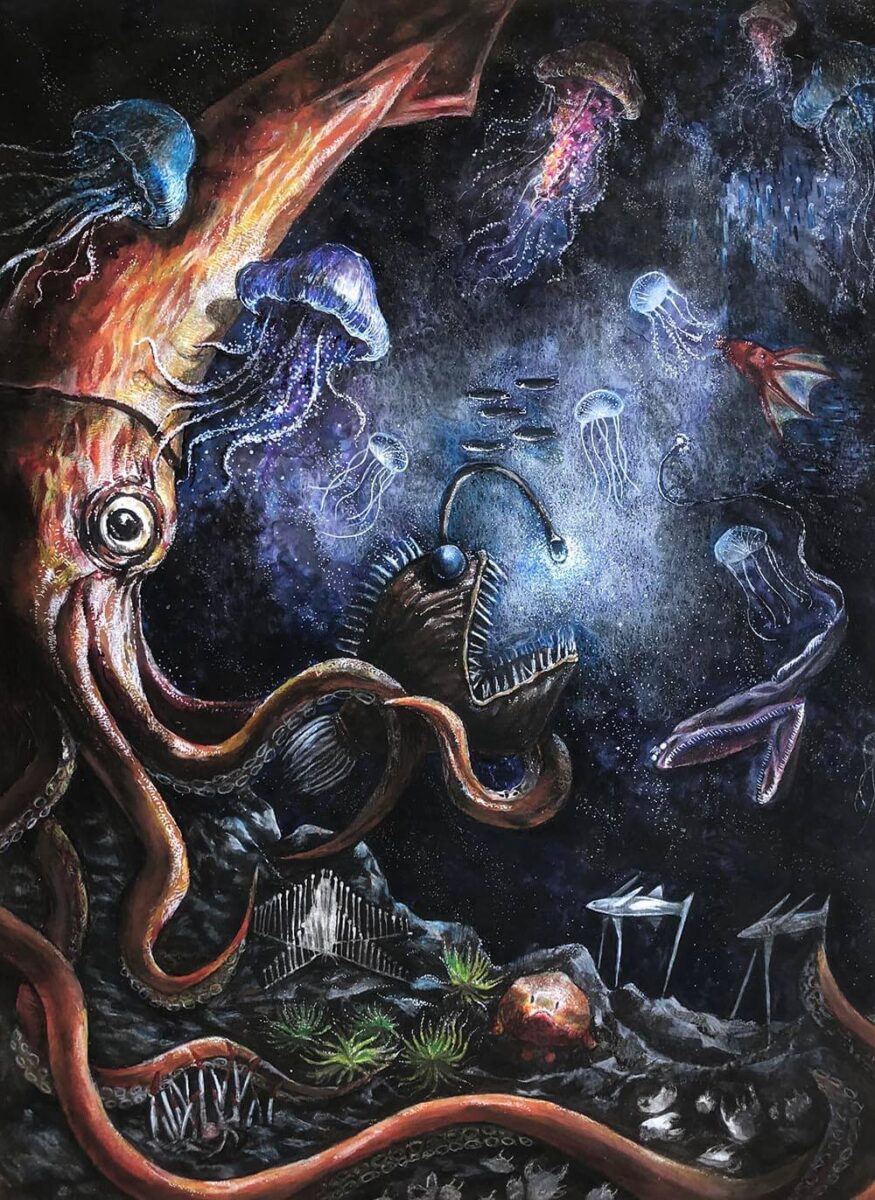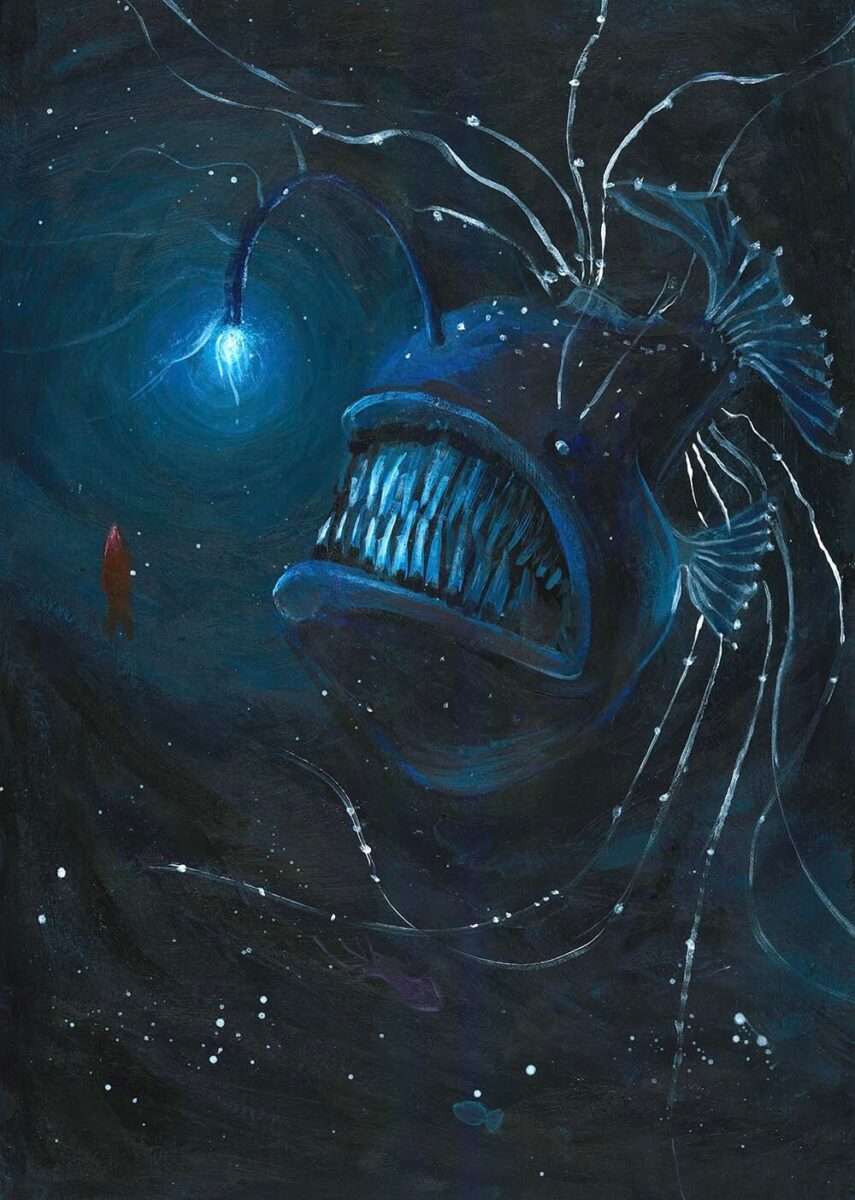
The Khaled bin Sultan Living Oceans Foundation’s annual art contest produces spectacular pieces inspired by life in the deep ocean
The theme for this year’s Science Without Borders Challenge – the annual art contest hosted by the Khaled bin Sultan Living Oceans Foundation (KSLOF) – was ‘Hidden Wonders of the Deep’, and school children from around the world have once again created some stunning works of art for the competition.
Held each year to promote ocean conservation and education, the competition is open to school students, split into two categories for ages 11-14 and 15-19 year-olds. More than 1,700 young artists from 82 countries participated in this year’s event, with the winners earning $500 from KSLOF to pursue their interests in art and ocean conservation.
‘These young artists have not only demonstrated exceptional talent but also a deep understanding of the importance of conserving the diversity of life in the ocean,’ said KSLOF’s Chief Operating Officer and Director of Education. ‘Their artwork serves as a powerful reminder of our responsibility to protect and conserve our oceans for future generations.’
Students and teachers interested in next year’s competition can learn more and apply at www.livingoceansfoundation.org/SWBchallenge.
Winner, 15-19
Eva Park (USA) – ‘Worlds Emerging’

In the 15-19 age group, the first-place winner in the 2024 Science Without Borders Challenge is 17-year-old Eva Park, from Studio City, California, with her stunning artwork, ‘Worlds Emerging’. Eva, who wishes to pursue a career in marine biology, uses the contrast of darkness and light to depict an oarfish emerging from the darkness of the deep sea, capturing ‘the sense of wonder in discovering the hidden world of deep sea creatures’.
Eva: The deep sea holds a plethora of mysteries, many of which are haunting and horrifying. Yet, it sparks fascination with its endless opportunities for discovery. The oarfish emerging from the dark represents the discoveries we have already made, and the siphonophore looms as a reminder of the otherworldliness often found in deep sea creatures. The darkness that shrouds both suggest that there is still much to uncover however. The darkness is not an indicator of lifelessness but is pregnant with possibilities. This feeling of mystery but intrigue is further emphasized by the vast biodiversity hidden in the dark, such as the chimaera shark, atolla jellies, schools of lantern fish, hadal snailfish, and the whale remains glinting in the background. Finally, the single light source coming from the viewer’s perspective shows the startle and wonder one might feel in discovering and witnessing such creatures swimming by in the dark depths.
Second place, 15-19
Nadia Cho (USA) – ‘Under the Sea’

16-year-old Nadia, from Las Vegas, Nevada, focuses her artwork on the intricate ecosystem around hydrothermal vents, showcasing the importance of tubeworms and their symbiotic relationship with chemosynthetic bacteria. Her piece highlights the unique beauty of this ecosystem and draws parallels to coral reefs, emphasizing how tubeworms, like corals, provide protection and habitat for many organisms.
Nadia: In the bathypelagic zone, tubeworms rest around hydrothermal vents. These tubeworms may seem a little grotesque by their mass numbers, but they are important for the surrounding life by the hydrothermal vents. The tubeworms have a symbiotic relationship with chemosynthetic bacteria inside their body. As the tubeworms transfer hydrogen sulfide from the vent water, the bacteria convert the hydrogen sulfide to food that the tube worm can eat. Since there are many tubworms, it provides a perfect shield to the Zoarcid fish who seek shelter from predators in the deep. Although the tubeworms may provide safety for a few species, they reminded me of the corals in coral reefs and how they provide the same thing for many different species. Hence why I illustrated the type of ecosystem the tubeworms live in and emphasise the beauty of its ecosystem.
Third place, 15-19
Jiayi (Jenny) Xu (USA) – ‘Look into the Light’
15-year-old Jenny Xu, from Fort Lee, New Jersey, claimed the third-place spot with a painting that offers an ominous yet captivating glimpse into the life of an anglerfish and its prey in the abyssopelagic zone. Her artwork portrays the allure and danger of the deep sea, incorporating elements of bioluminescence and newly discovered species.

Jenny: For this painting I created an ominous, frontal composition of an angler fish luring its surrounding creatures such as mantis shrimps and squid. I imagined what it must be like to live in an environment with the absence of light that’s filled with danger lurking in every corner. The bioluminescent lure of the angler fish creates light where there is none, becoming a transcendent object of otherworldly admiration/impending doom for those that become hypnotized by its wonder. The scene is emphasized by the hydrothermal vent and the imagined light rings that would both blind and captivate the unsuspecting prey. I also recently stumbled upon brand new discoveries of previously unknown species in the abyssopelagic zone under the sea as well as in Chile that I incorporated into my piece. In researching the deep seas, I was truly amazed at how forms of life can not only adapt to extreme environments
Winner, 11-14
Claire Kim (Canada) – ‘Wonders of the Twilight Zone’

Claire Kim, a 12-year-old student from Canada, was awarded as the 11-14 age group category winner for her artwork ‘Wonders of the Twilight Zone’. The judges said that Claire’s piece ‘offers a mesmerizing journey into the depths of the ocean, capturing the essence of the deep sea as a magical world full of vibrant colours and enchanting creatures, challenging common perceptions, and revealing the hidden beauty of the twilight zone.’
Claire: Under the deep sea where it is a dark world full of mysteries, there are weird creatures we have not seen. When we think of the deep dark parts of the ocean, the creatures that come to mind usually look unattractive, bizarre, or very unsettling. However deep down in the twilight zone, it is like various colours of fireworks. You can find life with vibrant pinks and blues like a whole new dimension with its own beauty and mysteries. Some even carry light and grace upon seeing them. When a light is lit in the twilight zone, we can see the many charmers who have been hiding in the dark. The deep sea is not all about the big, scary, ugly, or distorted looking creatures, it is about a magical world full of beauty and mesmerizing sights to behold.
‘Winning this art contest is a great achievement in my life,’ said Claire, ‘and I will definitely be entering the contest again next year.’
Second place, 11-14
Cheong Wong (China) – ‘Don’t Follow the Light’

11-year-old Cheong Wong from China took second place with a piece portraying an anglerfish using its glowing lure to capture prey.
Cheong: Deep, cold, and dark, this mysterious and unknown deep-sea world has the largest unknown biological system on Earth. It’s pretty ugly which name is anglerfish. It lives in a dark world where the sun is completely out of reach, where the water depth is more than 1,000 meters and its eyes have degenerated and shrunk.The food falls from the sea becomes less and less, it has evolved a huge mouth in order not to miss the scarce food. It uses sensitive hair on its body to sense the flow velocity of surrounding water. It has a long bait ball on its head, which emits a faint glow in the darkness and lures prey, when it feels the prey approaching, it immediately opens its huge mouth to suck in the prey with the seawater.I hope awaken everyone to cherish the magical beauty of colorful life in this dark kingdom on Earth.
Third place, 11-14
Felicia Fang (China) – ‘Praying’

14-year-old Felicia Fang, also from China, won third place for her artwork, which illustrates a variety of deep sea creatures feasting on a whalefall.
Felicia: In the past days, whale fall provides a great amount of nutrition for the marine animals, making the ocean full of vigour. The decorations on the skeleton present the beauty of life. However, under the gorgeous skeleton, there’s tons of trash and plastic objects, creating a strong contrast. As sea pollution is increasing, life is even more difficult for the deep sea animals due to the lack of foods. Only depending on a whale fall cannot support the survival of all deep sea creatures. Therefore, they decide to transfer the hope from depending on a whale fall to saving themselves on their own. The plastic tie around every creatures’ neck alerts them of this disaster, also reminding them to fight together. They share a part of their body to the others, praying for the end of this disaster, praying for the human being to leave a way out for them.
Honourable mentions
Entries into the 2024 Science Without Borders Challenge were of such exceptional quality that the judges added a new category, recognising three pieces of artwork focused on deep-sea exploration with honourable mentions.
Chloe Jeong (USA) – ‘Discovering the Undiscovered’

Chloe: My artwork depicts a deep-sea ecosystem that contains snailfish, bioluminescent jellyfish, anglerfish, reefs, whale fall, squid, eel, and marine worms. There is a person exploring inside a deep-sea submersible, which exhibits the methods humans utilize to unveil the mysteries of the deep. The fascinating deep-sea organisms are located inside and outside of the deep sea submersible. This represents how humans and the creatures of the deep sea are both on Earth but are barred from interaction due to the extremely different environments. Furthermore, my artwork illustrates a person inside the submersible closely observing a snailfish, which was recently discovered to be the deepest living fish. This represents that although the deep sea is mostly unexplored, more hidden wonders of the intriguing ecosystem are gradually being brought to light.
Zoe Cheng (Taiwan) – ‘Glowing Allure from the Deep’

Zoe: My artwork unveils the unique beauty of the ocean’s depths, with a focus on the Mesopelagic and Bathypelagic zones. Through vibrant portrayals of creatures like the Anglerfish and Gulper Eel, I aim to showcase their fascinating adaptations. Puzzle pieces symbolize the mysteries awaiting discovery, while the diver represents humanity’s intention to coexist with these creatures. Each organism, from the Vampire Squid to the Lion’s Mane Jellyfish, embodies the diversity of the deep sea. I play with the unique aesthetic of bioluminescence, drawing attention to prey and enabling navigation in the dark to highlight the diverse adaptations of these creatures. Additionally, this exploration not only enhances ocean literacy but also serves as an inspiration for youth to pursue careers in STEM fields, fostering a clearer understanding and stronger connection to the ‘hidden wonders of the deep’.
Sarah Peng (Canada) – ‘Nature’s Wonderland’

Sarah: Contemplating the deep sea often conjures images of unsettling creatures with sharp fangs and distorted features, yet this perception obscures the true beauty of the unknown: the continuously unveiled universe of bioluminescence. In my piece, I aim to highlight the misunderstood charm of its creatures, depicting the collision between the known human realm and the colorful fantasy of the deep sea. As the diver, representing humanity’s still developing knowledge, reaches towards a comb jelly’s frame, epitomizing the foreign world of bioluminescence, radiant light scatters across the darkness, symbolizing the beauty of connection. Surrounding them are sea angels, Atolla jellyfish, gossamer worms, firefly squid, Halitrephes Maasi, and crystal jelly, showcasing the remarkable diversity of this seemingly empty region. Thriving in specific conditions between the mesopelagic and abyssalpelagic zones, they symbolize the beauty of untouched life. The comb jelly, notoriously fragile and delicate, highlights the flawless balance of the natural world.


